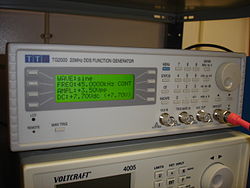- Direct digital synthesizer
-
Direct Digital Synthesizer (DDS) is a type of frequency synthesizer used for creating arbitrary waveforms from a single, fixed-frequency reference clock. Applications of DDS include: signal generation, local oscillators in communication systems, function generators, mixers, modulators,[1] sound synthesizers and as part of a digital phase-locked loop.[2]
Contents
Overview
 Figure 1 - Direct Digital Synthesizer block diagram
Figure 1 - Direct Digital Synthesizer block diagramA basic Direct Digital Synthesizer consists of a frequency reference (often a crystal or SAW oscillator), a numerically controlled oscillator (NCO) and a digital-to-analog converter (DAC) [5] as shown in Figure 1.
The reference provides a stable time base for the system and determines the frequency accuracy of the DDS. It provides the clock to the NCO which produces at its output a discrete-time, quantized version of the desired output waveform (often a sinusoid) whose period is controlled by the digital word contained in the Frequency Control Register. The sampled, digital waveform is converted to an analog waveform by the DAC. The output reconstruction filter rejects the spectral replicas produced by the zero-order hold inherent in the analog conversion process.
Performance
A DDS has many advantages over its analog counterpart, the phase-locked loop (PLL), including much better frequency agility, improved phase noise, and precise control of the output phase across frequency switching transitions. Disadvantages include spurious due mainly to truncation effects in the NCO, crossing spurious resulting from high order (>1) Nyquist images, and a higher noise floor at large frequency offsets due mainly to the Digital-to-analog converter.[6]
Because a DDS is a sampled system, in addition to the desired waveform at output frequency Fout, Nyquist images are also generated (the primary image is at Fclk-Fout, where Fclk is the reference clock frequency). In order to reject these undesired images, a DDS is generally used in conjunction with an analog reconstruction lowpass filter as shown in Figure 1.[7]
Frequency agility
The output frequency of a DDS is determined by the value stored in the frequency control register (FCR) (see Fig.1), which in turn controls the NCO's phase accumulator step size. Because the NCO operates in the discrete-time domain, it changes frequency instantaneously at the clock edge coincident with a change in the value stored in the FCR. The DDS output frequency settling time is determined mainly by the phase response of the reconstruction filter. An ideal reconstruction filter with a linear phase response (meaning the output is simply a delayed version of the input signal) would allow instantaneous frequency response at its output because a linear system can not create frequencies not present at its input.[8]
Phase noise and jitter
The superior close-in phase noise performance of a DDS stems from the fact that it is a feed-forward system. In a traditional phase locked loop (PLL), the frequency divider in the feedback path acts to multiply the phase noise of the reference oscillator and, within the PLL loop bandwidth, impresses this excess noise onto the VCO output. A DDS on the other hand, reduces the reference clock phase noise by the ratio fclk / fo because its output is derived by fractional division of the clock. Reference clock jitter translates directly to the output, but this jitter is a smaller percentage of the output period (by the ratio above). Since the maximum output frequency is limited to fclk / 2, the output phase noise at close-in offsets is always at least 6dB below the reference clock phase-noise.[6]
At offsets far removed from the carrier, the phase-noise floor of a DDS is determined by the power sum of the DAC quantization noise floor and the reference clock phase noise floor.
See also
- Numerically controlled oscillator
- Digital-to-analog converter
- Reconstruction filter
- Crystal oscillator
References
- ^ "DDS Controls Waveforms in Test, Measurement, and Communications". Analog Devices Corporation. http://www.analog.com/library/analogdialogue/archives/39-08/dds_apps.html.
- ^ Paul Kern (July 2007). "Direct digital synthesis enables digital PLLs". RFDesign. http://rfdesign.com/mag/707RFDF2.pdf.
- ^ "Numerically Controlled Oscillator". Lattice Semiconductor Corporation. 2009. http://www.latticesemi.com/products/intellectualproperty/ipcores/numericallycontrolledosci/index.cfm.
- ^ Jane Radatz, The IEEE Standard Dictionary of Electrical and Electronics Terms, IEEE Standards Office, New York, NY, 1997
- ^ While some authors use the terms DDS and NCO interchangeably,[3] by convention an NCO refers to the digital (i.e. the discrete-time, discrete amplitude) portion of a DDS[4]
- ^ a b "Single-Chip Direct Digital Synthesis vs. the Analog PLL". Analog Devices Corporation. http://www.analog.com/library/analogDialogue/archives/30-3/single_chip.html.
- ^ Kroupa,Venceslav F.,Direct Digital Frequency Synthesizers, IEEE Press, 1999, ISBN 0-7803-3438-8
- ^ Chen, C.T. (1970). Introduction to Linear System Theory. Holt, Rinehart and Winston, Inc.. ISBN 03-077155-2.
External links
- Tutorial on Digital Signal Synthesis (From Analog Devices)
- Another thesis on high speed DDS (French)
- L. Cordesses, "Direct Digital Synthesis: A Tool for Periodic Wave Generation (Part 1)" IEEE Signal Processing Magazine, DSP Tips & Tricks column, pp. 50–54, Vol. 21, No. 4 July 2004.
- L. Cordesses, Direct Digital Synthesis: A Tool for Periodic Wave Generation (Part 2) IEEE Signal Processing Magazine, DSP Tips & Tricks column, pp. 110–117, Vol. 21, No. 5, Sep. 2004.
Categories:- Digital signal processing
- Oscillators
Wikimedia Foundation. 2010.

